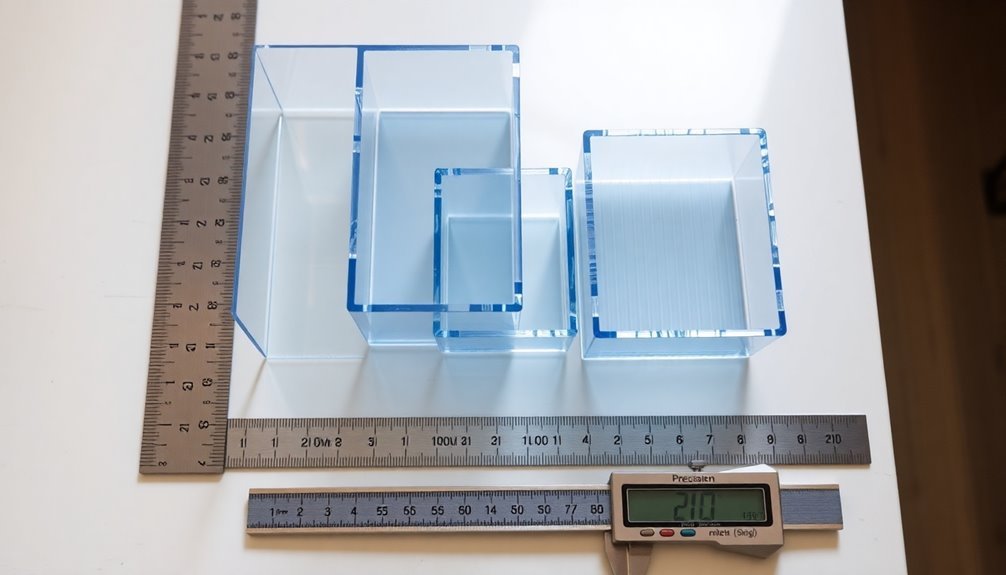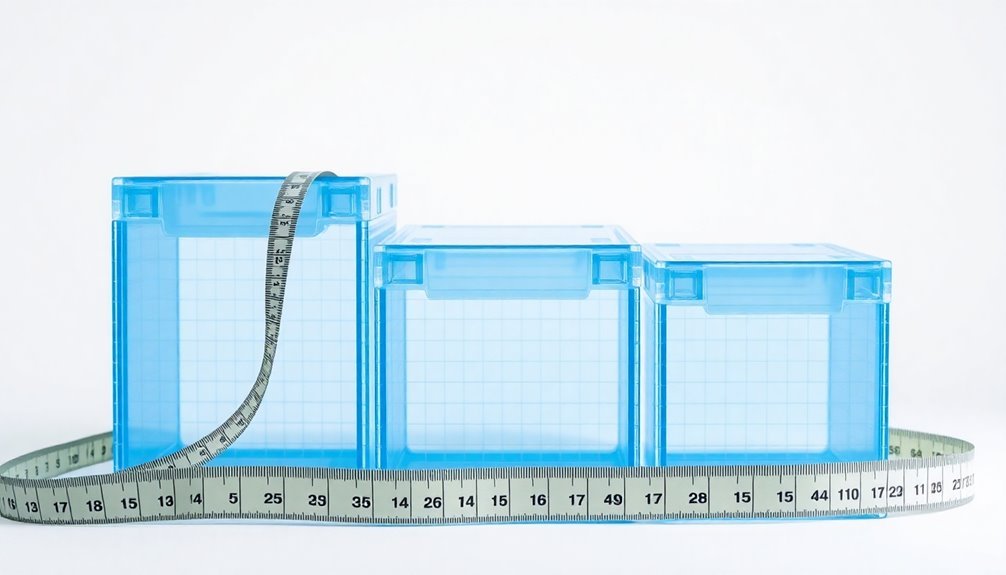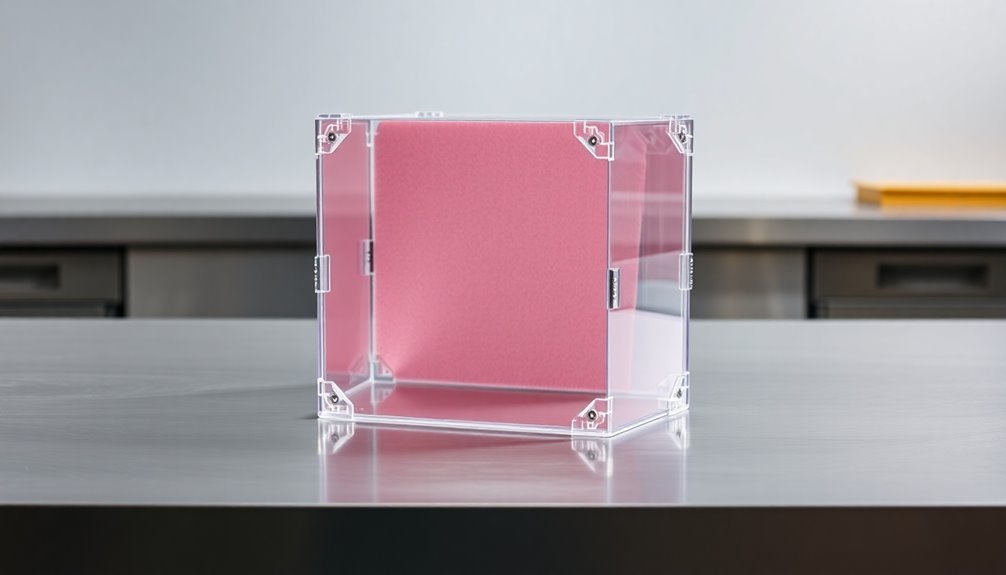When selecting anti-static box dimensions, you'll need to focus on three key factors. First, consider standard lengths of 426mm or 215mm, which are widely available and cost-effective for most applications. Second, make sure you're accounting for both internal and external measurements – internal dimensions must accommodate your components with proper clearance. Third, don't forget surface resistivity requirements of 10^3-10^9 ohms for ideal protection of sensitive electronics. While these standard sizes work for many needs, exploring custom options like the GSB-100 or Flex-A-Top series can provide tailored solutions for your specific requirements.
Measuring for Perfect Fit

Getting the right measurements for your anti-static box is essential for protecting sensitive electronic components. When measuring for a perfect fit, you'll need to evaluate four key dimensions: length, width, height, and depth.
Standard lengths like 426mm and 215mm are common, but you can customize dimensions up to 1220mm x 2440mm for larger requirements. The surface resistivity range of 10^3-10^9 ohms ensures optimal static protection for your components. The black conductive polypropylene construction provides additional protection against static buildup.
For width measurements, you've got flexibility ranging up to 1750mm, with common specifications like 50.8mm for smaller components.
The height of your box is equally important – options typically range from 6.4mm to 33mm, with popular sizes including 13.5mm, 16mm, and 17mm. If you're planning to stack your boxes, assess the 10.7mm height option specifically designed for stackability.
Don't forget to factor in both internal and external dimensions when selecting your box size.
For example, if you're storing FIB lift-out grids, you'll need precise measurements of 55 x 51 x 10.7mm.
Remember that manufacturers can post-process boxes to match your specific requirements, so you're not limited to standard sizes if your components need custom dimensions.
Common Box Size Standards
Across the electronics industry, several anti-static box sizes have emerged as trusted standards. You'll find that smaller containers like the Anti-Static GSB-100 Storage Box measure just 55 x 51 x 10.7mm, perfect for delicate components like TEM grids.
The Flex-A-Top FT14-ASP offers a slightly larger option at 2.50" x 1.61" x 1.00", while the Laboxx 291910-CAS provides more space at 3.13" x 2.14" x 1.14". The Laboxx series features a two-piece lid design that ensures contents remain securely enclosed. Made from high-quality polypropylene, these containers offer surface resistivity protection between 1 x 10 to 9.9 x 10 ohms per square.
When you need larger storage solutions, the Corstat Correc Pak series offers multiple standardized sizes, ranging from 4" x 4" x 2" to 9" x 7.5" x 1.5".
For industrial-scale requirements, you can turn to ESD Corrugated Boxes, which come in a standard 1220mm x 2440mm specification with customizable options.
Each size standard serves specific applications – from the GSB-100's specialized FIB Lift-Out TEM Grid storage to the Laboxx's medical and pyrotechnic industry uses.
You'll notice that manufacturers have designed these boxes with practical features like hinged lids, stackability, and varying materials from conductive plastic to dissipative foam, ensuring proper ESD protection regardless of size choice.
Customization Vs Standard Dimensions

While standard box sizes meet many common needs, the choice between customized and standard dimensions often depends on your specific requirements. When selecting between custom and standard options, you'll need to evaluate material properties, application needs, and cost implications.
| Aspect | Standard Dimensions | Custom Dimensions |
|---|---|---|
| Cost | Lower unit cost | Higher initial investment |
| Lead Time | Immediate availability | Longer production time |
| Material Options | Limited selection | Wide range of choices |
| Volume Requirements | Better for regular needs | Ideal for unique specs |
| Industry Compliance | General certifications | Application-specific standards |
You'll find that standard ESD boxes come in common sizes like 2.50" x 1.61" x 1.00" and 3.13" x 2.14" x 1.14", which work well for general electronics storage. However, if you're working with specialized components or unique applications, custom dimensions might be necessary. Materials like polypropylene and ABS offer different benefits – polypropylene provides strength and recyclability, while ABS delivers chemical resistance. For large-scale operations, you'll benefit from quantity pricing on standard sizes, but custom solutions might prove more cost-effective if they reduce waste or improve protection for specific items. With ESD safe die-cut foam interiors available, you can enhance protection for sensitive electronic components while maintaining standardized exterior dimensions.
Frequently Asked Questions
How Long Do Anti-Static Properties Remain Effective in Standard Boxes?
You'll find that anti-static properties typically remain effective for 6 months to 2 years, but this depends on your storage conditions, handling practices, and the quality of materials used in manufacturing.
Can Anti-Static Boxes Be Safely Stacked Without Compromising Their Protective Features?
Yes, you can safely stack anti-static boxes as they're designed with reinforced structures and conductive materials that maintain ESD protection when stacked. Just verify you're following proper grounding procedures while handling them.
What Temperature Range Can Standard Anti-Static Boxes Safely Withstand?
You can safely use standard anti-static boxes between -60° F and 250° F. They'll handle dishwasher temperatures and boiling water well, but don't use them in microwaves or near open flames.
Are Anti-Static Boxes Reusable After Exposure to High Humidity Environments?
You shouldn't reuse anti-static boxes after high humidity exposure without testing them first. They can lose their static-dissipative properties. If needed, use desiccant packs and inspect thoroughly before reusing.
Do Anti-Static Boxes Require Special Cleaning Procedures to Maintain Their Protective Properties?
Yes, you'll need special cleaning procedures to maintain anti-static properties. Use only ESD-safe cleaners, avoid regular detergents and alcohol-based products, and follow manufacturer's guidelines to prevent damaging the box's protective coating.
In Summary
You'll want to measure your components carefully and consider both standard sizes and custom options for your anti-static storage needs. While industry-standard dimensions like 4x4x1.5 inches or 6x4x2 inches work well for most electronics, don't hesitate to customize if your items require special protection. Remember that proper fit isn't just about convenience—it's essential for protecting your sensitive electronic components from static damage.





Leave a Reply